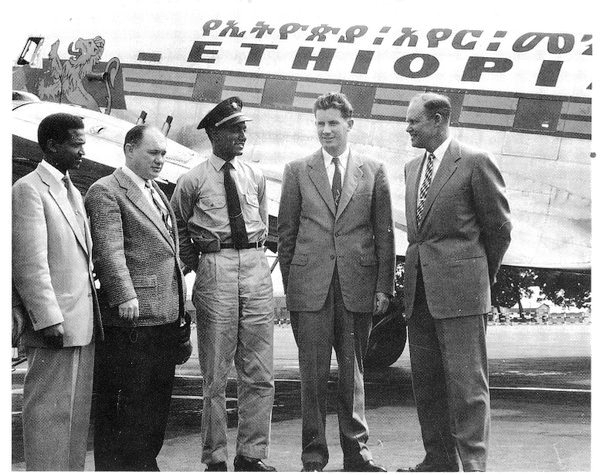While Ethiopian Airlines began commercial operations in 1946 with American aircrews, the first four Ethiopian pilots commenced their training with the airline on May 23, 1951. Despite having no prior exposure to mechanical vehicles, these trainee pilots displayed outstanding performance, even though they were trained on the metal SAAB Safir, considered too complex for basic training. Among them was Alemayehu Abebe, who later became the first Ethiopian captain in 1957, accomplishing his solo flight on a DC-3/C-47 aircraft at the age of 32.
During a period when both the management and flight operations were dominated by Americans, many of them believed that the locals had no business in the cockpit, Alemayehu’s hard work and determination paid off, making him not only the first Ethiopian pilot but also the first black African. He added another aviation milestone to his career when he became the first African to fly the Atlantic solo in 1962, piloting Boeing 720Bs recently acquired by the airlines.
As he recounted it in his memoir, “Hiwote Bemidir Na Bayer” (My Life on Land and Air) which came out in 2005, Alemayehu explained the significant challenges and prejudices faced by himself and other prospective pilots from the American management. ” The American management resisted the idea of allowing locals to fly, relegating us to support positions,” he wrote. “We presented our plight to the Airline’s board, but there was no solution. We were told that all technical issues were the Americans’ jurisdiction, and it was not possible to challenge it”. Alemayehu highlighted how the Americans exploited this situation as a means of control, asserting their dominance. “They argued since most of the passengers were foreigners, they said they had no faith in black pilots and mechanics -a viewpoint unfortunately also subscribed to by our officials,” he added. “I understood early that the solution was not to fall into accusation and blame, but rather to excel in the aviation field and to demonstrate a comparable intellectual and technical expertise to them,” he said. “I had graduated first in my class in the training mission. All the captains I flew with confirmed that I did an excellent job and was qualified to sit for an exam to earn the license. But the bosses were not happy about the thought of me and other Ethiopians being captains. They came up with lame excuses such as saying our technical abilities were not yet developed and we had not yet won the passenger’s trust.”

Eager to support himself, Alemayehu landed his first job in the post office. After the liberation, he came to Addis Ababa and attended high school at the Addis Ababa Medhanialem School, known then as (Balabat (Nobility school). After graduating high school with high distinction, he was among the few students selected to join the Imperial Ethiopian Air Force’s flying school, which had just been established with the help of Swedish instructors. He attended primary training at Debre Zeit and headed to Sweden for advanced training for a year. Upon his return, he was promoted to Wing Commander with the rank of Flight Lieutenant. In 1951 when pilots were released from the Air Force to the Ethiopian Airlines, Alemayehu became among the the first group pilots along with Semret Medhane, who later became the first Ethiopian to assume the post of General Manager in 1971.
Alemayheu is survived by eight children and four grandchildren.




